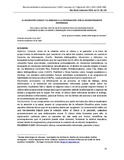| dc.rights.license | http://creativecommons.org/licenses/by-nc-sa/3.0/ve/ | |
| dc.contributor.author | Aguilera Fernández, David | |
| dc.contributor.author | Borges de Meneses, Ramiro Délio | |
| dc.date.accessioned | 2018-02-26T15:04:24Z | |
| dc.date.available | 2018-02-26T15:04:24Z | |
| dc.date.issued | 2018-03 | |
| dc.identifier.issn | 2244-7482 | |
| dc.identifier.uri | http://www.saber.ula.ve/handle/123456789/44378 | |
| dc.description.abstract | Objetivo: Conocer cómo es la relación entre el clínico y el paciente a la hora de proporcionar la información que concierne a la salud del usuario, teniendo en cuenta el Derecho de información. Diseño: Revisión bibliográfica. Materiales y Métodos: La búsqueda incluyó publicaciones que no superaran los 10 años de antigüedad y cuyo texto completo fuese encontrado, centrándose principalmente en revisiones sistemáticas. La búsqueda de revisiones sistemáticas actualizadas en el ámbito de estudio elegido a través de: La Biblioteca Cochrane Plus, Pubmed Health, Metabuscadores como Trip, Bases de datos bibliográficas como CUIDEN, PubMed y Otras fuentes como Google académico y revistas. Los estudios seleccionados fueron sometidos previamente a un programa de habilidades de lectura crítica (CASPe), cuyas puntuaciones fueron superiores a 7.
Resultados principales: La información es un proceso, se trata de diálogo, dicha información y la obtención del consentimiento informado puede variar entre los pacientes, resultando fácil y rápido en algunos casos y en otros puede requerir tiempo. El clínico debe proporcionar tiempo para que el paciente asimile la información y exprese las dudas y preguntas que le surjan. Por ende, el clínico debe esforzarse durante el diálogo, comunicándose e informando, para dar forma y ver los límites del proceso y dar aclaración al consentimiento del paciente. Conclusiones: Es un compromiso con la bioética, por parte de todos los clínicos implicados en la atención a la salud, asumir el compromiso de la reflexión filosófica sobre todos aquellos dilemas éticos que en la práctica diaria van surgiendo. La comunicación debe ser una herramienta básica para la relación entre el clínico y el paciente, usándose posteriormente en una deliberación moral. El clínico debe fomentar para ello: la exploración continua sobre su paciente sin dar nada por hecho, identificar las preocupaciones que el paciente puede estar viviendo, fomentar la actitud empática, actuar desde la congruencia y proporcionar la creación de un vínculo terapéutico. | es_VE |
| dc.language.iso | es | es_VE |
| dc.rights | info:eu-repo/semantics/openAccess | |
| dc.subject | Información clínica | es_VE |
| dc.subject | Consentimiento informado | es_VE |
| dc.subject | Paciente y leyes | es_VE |
| dc.title | El encuentro Clínico y el Derecho a la Información: Por el Consentimiento Informado. | es_VE |
| dc.title.alternative | The clinical Meeting and the Right to Information: For Informed Consent. | es_VE |
| dc.title.alternative | A Assembléia Clínica e o Direito à Informação: Para o Consentimento Informado. | es_VE |
| dc.type | info:eu-repo/semantics/article | |
| dc.description.abstract1 | Objective: To know how the relationship between the clinic n and the patient is in providing the information that concerns the health of the user, taking into account the Right of Information. Design: Bibliographic review. Materials and Methods: The search included publications that it did not exceed then years of age and whose complete text was found, focusing on systematic reviews. The search for updated systematic reviews in the chosen field of study through: The Cochrane Library Plus, Pubmed Health, Metabuscadores such as Trip, Bibliographic databases such as CUIDEN PubMed and other sources such as Google academic and magazines. The selected studies were previously submitted to a critical reading skills program (CASPe), whose scores were higher than seven. Fundamental Results: Information is a process, it is about dialogue, this information and obtaining informed consent can vary among patients, it is easy and fast in some cases and in others it may take time. The clinician should provide time for the patient to assimilate the information and express the doubts and questions that arise. Therefore, the clinician should strive during the dialogue, communicating and informing, to shape and see the limits of the process and clarify the consent of the patient. Conclusions: It is a commitment to Bioethics, on the part of all the clinicians involved in health care, to assume the commitment of philosophical reflection on all those ethical dilemmas that arise in daily practice. Communication should be a basic tool for the relationship between the clinician and the patient, and then used in moral deliberation. The clinician should encourage continuous exploration of his patient without giving anything for granted, identify the concerns that the patient may be experiencing, encourage the empathic attitude, act from the congruence and provide the creation of a therapeutic link. | es_VE |
| dc.description.colacion | 81-101 | es_VE |
| dc.description.email | borges272@gmail.com | es_VE |
| dc.description.frecuencia | semestral | |
| dc.identifier.depositolegal | ppi200802ME3759 | |
| dc.publisher.pais | Venezuela | es_VE |
| dc.subject.facultad | Facultad de Medicina | es_VE |
| dc.subject.keywords | Clinical information | es_VE |
| dc.subject.keywords | Informed consent | es_VE |
| dc.subject.keywords | Patient and law | es_VE |
| dc.subject.publicacionelectronica | Revista de Bioética Latinoamericana | |
| dc.subject.seccion | Revista de Bioética Latinoamericana: Artículos | es_VE |
| dc.subject.thematiccategory | Medicina y Salud | es_VE |
| dc.subject.tipo | Revistas | es_VE |
| dc.type.media | Texto | es_VE |


